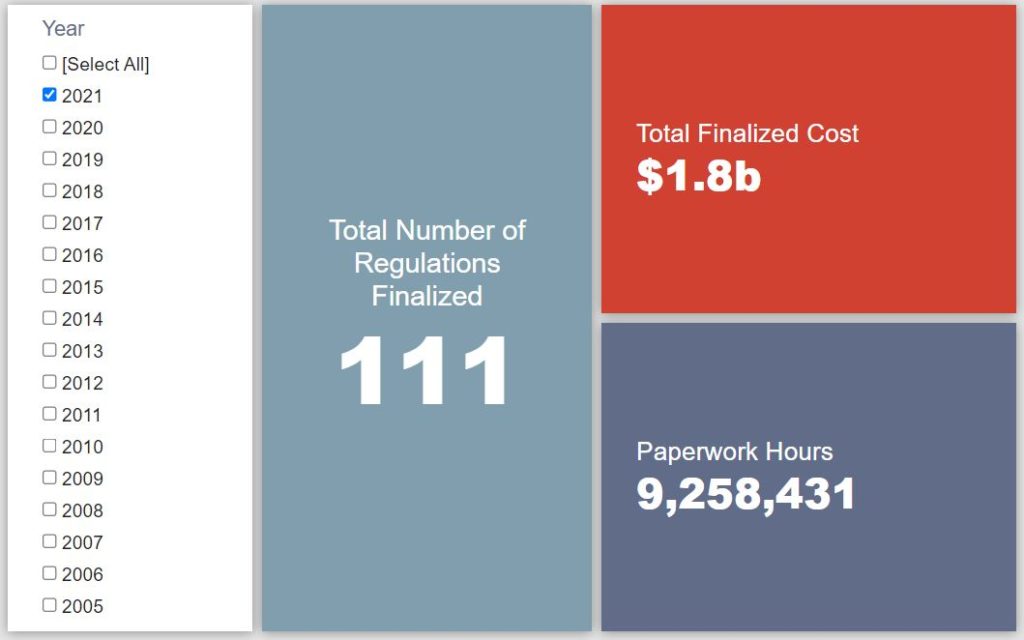Week in Regulation
June 1, 2021
A Very Neutral End to May
Heading into the holiday weekend, the last week of May was something of a dud on the regulatory front. A handful of fairly modest actions combined to yield a net economic impact of less than a million dollars. Across all rulemakings, agencies published roughly $800,000 in total net cost savings and cut 47,186 annual paperwork burden hours.
REGULATORY TOPLINES
- Proposed Rules: 36
- Final Rules: 62
- 2021 Total Pages: 29,125
- 2021 Final Rule Costs: $1.8 Billion
- 2021 Proposed Rule Costs: -$14 billion
NOTABLE REGULATORY ACTIONS
The most significant action of the week was a Department of Labor (DOL) proposed rule on “Rescission of Labor Organization Annual Financial Report for Trusts in Which a Labor Organization Is Interested, Form T-1.” (See “This Week’s Regulatory Picture” below for further details on the rulemaking and its history.) DOL estimates that these proposed changes would cut paperwork for labor organizations by approximately 174,000 hours each year (or $10.4 million in annual costs).
The most notable cost-adding action was a joint “temporary rule” from DOL and the Department of Homeland Security regarding “Exercise of Time-Limited Authority To Increase the Fiscal Year 2021 Numerical Limitation for the H-2B Temporary Nonagricultural Worker Program and Portability Flexibility for H-2B Workers Seeking To Change Employers.” The agencies are using “time-limited Fiscal Year (FY) 2021 authority and increasing the numerical limitation on H-2B nonimmigrant visas to authorize the issuance of no more than 22,000 additional visas through the end of the second half of FY 2021.” This one-time action includes 32,023 hours of paperwork and roughly $18.1 million in administrative costs.
CONGRESSIONAL REVIEW ACT UPDATE
On March 23, the first joint resolution of disapproval under the Congressional Review Act (CRA) of this term was introduced. CRA resolutions essentially seek to wholly rescind specific final rules within a set timeframe. The significance of these resolutions is discussed further here. In the interest of providing a public accounting of the potential economic impact of these actions should they pass, the American Action Forum (AAF) will provide a regular update of the rules being targeted and a concise summary of each rule’s purpose, economic impact, and why opponents may be targeting it.
This past week saw the passing of the deadline for the Senate to vote on CRA resolutions without the potential of a filibuster. This means that, in all likelihood, the three resolutions that have passed that chamber thus far are the only CRA resolutions that stand to be passed into law for at least the foreseeable future. Those resolutions are still awaiting a vote in the House and President Biden’s (expected) approval.
TRACKING THE ADMINISTRATIONS
As we have already seen from executive orders and memos, the Biden Administration will surely provide plenty of contrasts with the Trump Administration on the regulatory front. And while there is a general expectation that the new administration will seek to broadly restore Obama-esque regulatory actions, there will also be areas where it charts its own course. Since the AAF RegRodeo data extend back to 2005, it is possible to provide weekly updates on how the top-level trends of President Biden’s regulatory record track with those of his two most recent predecessors. The following table provides the cumulative totals of final rules containing some quantified economic impact from each administration through this point in their respective terms.
![]()
After a couple of weeks of the Biden Administration surging ahead in terms of to-date regulatory activity, it slowed down quite a bit last week. Final rules from the current administration added up to roughly $27 million and 128,000 hours of paperwork. Meanwhile, the most pronounced spike across the three administrations came in the Obama paperwork tally jumping by roughly 3.7 million, thanks largely to a single rule regarding “Hours of Service of Railroad Employees.”
THIS WEEK’S REGULATORY PICTURE
This week, DOL proposes to rescind a Trump Administration rule that required additional disclosures from labor unions.

On May 27, the DOL’s Office of Labor-Management Standards (OLMS) proposed to rescind a Trump Administration rule issued in March 2020 regarding OLMS’s Form T-1. The proposal, which would eliminate the Form T-1, is the latest phase of a two-decades-long regulatory battle largely driven by politics.
Labor unions are required to make annual disclosures of financial information under the Labor-Management Reporting and Disclosure Act, a 1959 law. This is primarily done through the Form LM-2, which covers larger unions. In 2003, the Bush Administration’s DOL finalized a rule that eliminated the requirement that certain information on trusts be reported on that form, and instead required unions to file a separate Form T-1 for each trust, which would take about 30 hours per respondent per year (following the first year where it would take about 70 hours). The Form T-1 required a lot more information than previously submitted, so much so that a court vacated parts of the rule for requiring “information unrelated to union reporting requirements.” A subsequent rule was issued in the waning days of the Bush Administration.
Upon entering office, the Obama Administration rescinded the rule, arguing that the “reporting required under the rule to be overly broad and not necessary to prevent circumvention or evasion of Title II reporting requirements.” The Trump Administration rebooted the Form T-1 last year, reasoning that the requirements were “in line with contemporary expectations for the disclosure of financial information.”
The Biden Administration is proposing to rescind the Form T-1 once again, using similar arguments that the Obama Administration offered but going further to claim that rule’s reporting requirements are not justified given the burden they impose.
TOTAL BURDENS
Since January 1, the federal government has published $12.2 billion in total net cost savings (with $1.8 billion in new costs from finalized rules) and 2.5 million hours of net annual paperwork burden reductions (with 9.3 million hours in increases from final rules).












